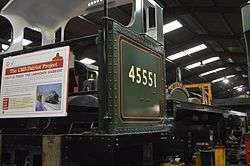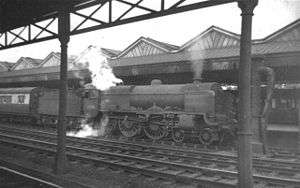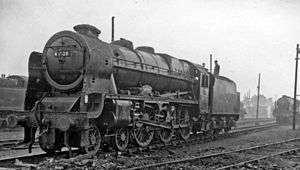LMS Patriot Class
|
45501 St. Dunstans at Stafford, 1954 | |||||||||||||||||||||||||||||||||||||||||||||||||||
| |||||||||||||||||||||||||||||||||||||||||||||||||||
| |||||||||||||||||||||||||||||||||||||||||||||||||||
| |||||||||||||||||||||||||||||||||||||||||||||||||||
| |||||||||||||||||||||||||||||||||||||||||||||||||||
|
45528 R.E.M.E. in November 1962 | |||||||||||||||||||||||||||||
| |||||||||||||||||||||||||||||
| |||||||||||||||||||||||||||||
| |||||||||||||||||||||||||||||
| |||||||||||||||||||||||||||||
The Patriot Class was a class of 52 express passenger steam locomotives built for the London Midland and Scottish Railway. The first locomotive of the class was built in 1930 and the last in 1934. All of the Patriot class locomotives were withdrawn from service by 1965. The class was based on the chassis of the Royal Scot combined with the boiler from Large Claughtons earning them the nickname Baby Scots.
Overview
The first two were rebuilt in 1930 from the 1912-built LNWR Large Claughton Class, retaining the original driving wheels with their large bosses, the "double radial" bogie truck and some other parts. Of the subsequent 50 locomotives of the class 40 were nominal rebuilds of Claughtons, being in fact new builds classified as rebuilt engines so that they could be charged to revenue accounts, rather than capital. The last ten were classified as new builds.
The two former Claughtons retained their original numbers until 1934, when they were renumbered 5500–1.[1] The 40 built as replacements took the numbers of the Claughtons that they replaced; these were renumbered 5502–41 in 1934.[2] The remainder of the class were allocated nos. 6030–9, but were numbered 5542–51 from new.[3] BR added 40000 to their numbers to make them 45500–51. The numbering of the similar LMS Jubilee Class continued on from where the Patriots left off. This was because 5552–5556 were ordered as Patriots (to be numbered 6040–4) but built with taper boilers as Jubilees on the orders of Sir William Stanier.[4]
Naming of the class was somewhat erratic. Some retained old Claughton names, whilst others continued the military associations of the names Patriot and St Dunstans, and 13 carried names of holiday resorts served by the LMS. Seven remained unnamed, although they had been allocated names in 1943.
Between 1946 and 1948 eighteen were rebuilt with Stanier 2A boiler, cab and tender, though again these were paper rebuilds. The rebuilt engines were (4)5512/14/21–23/25–32/34–36/45. These were originally built without smoke deflectors but starting in 1948 were fitted with LMS Royal Scot Class pattern deflectors. The two original members of the class, and the first ten of the nominal rebuilds, were not rebuilt due to their non-standard parts.
All were withdrawn between 1960 and 1965. None have survived to preservation.
In 2007 a proposal to build a new LMS Patriot, using the surviving drawings, was published in the 13 July issue of Steam Railway magazine. This led to the formation of a Limited Company with charitable status.
Accidents and incidents
- On 13 March 1935, a milk train was in a rear-end collision with an express freight train at King's Langley, Hertfordshire due to a signalman's error. Locomotive No. 5511 was hauling a freight train that collided with the wreckaged. A fourth freight train then ran into the wreck. One person was killed.[5]
- On 16 October 1939, locomotive No. 5544 was hauling a train that was in a collision with another train at Winwick Junction, Cheshire and was derailed.[6]
- On 13 October 1940, locomotive No. 5529 was hauling an express passenger train that collided with a platform barrow obstructing the line at Wembley Central station, Middlesex and was derailed. Several people were killed and many more were injured.[7]
Details
| Pre- 1934 LMS No. |
Post 1934 LMS No. (BR + 40000) |
Name (date if not from new) | Built | Works | Withdrawn | Notes |
|---|---|---|---|---|---|---|
| 5971 | 5500 | Patriot (Feb. 1937) | November 1930 | Derby | March 1961 | Original name – Croxteth. |
| 5902 | 5501 | St. Dunstans (1937) | November 1930 | Derby | September 1961 | Original name – Sir Frank Ree. |
| 5959 | 5502 | Royal Naval Division (1937) | July 1932 | Crewe | September 1960 | |
| 5985 | 5503 | The Leicestershire Regiment (1938) | July 1932 | Crewe | August 1961 | The Royal Leicestershire Regiment from Nov. 1948. |
| 5987 | 5504 | Royal Signals (1937) | July 1932 | Crewe | March 1962 | |
| 5949 | 5505 | The Royal Army Ordnance Corps (1947) | August 1932 | Crewe | June 1962 | |
| 5974 | 5506 | The Royal Pioneer Corps (Sep. 1948) | August 1932 | Crewe | March 1962 | |
| 5936 | 5507 | Royal Tank Corps (1937) | August 1932 | Crewe | October 1962 | |
| 6010 | 5508 | August 1932 | Crewe | November 1960 | Fitted with stovepipe chimney in 1956. | |
| 6005 | 5509 | The Derbyshire Yeomanry (1951) | August 1932 | Crewe | August 1961 | |
| 6012 | 5510 | August 1932 | Crewe | June 1962 | ||
| 5942 | 5511 | Isle of Man (1938) | September 1932 | Crewe | February 1961 | |
| 5966 | 5512 | Bunsen | September 1932 | Crewe | March 1965 | Rebuilt Jul. 1948. |
| 5958 | 5513 | September 1932 | Crewe | September 1962 | 1943 name allocated: Sir W.A. Stanier. | |
| 5983 | 5514 | Holyhead (1938) | September 1932 | Crewe | June 1961 | Rebuilt Mar. 1947. |
| 5992 | 5515 | Caernarvon (1939) | October 1932 | Crewe | June 1962 | |
| 5982 | 5516 | The Bedfordshire and Hertfordshire Regiment. (1938) | October 1932 | Crewe | August 1961 | |
| 5952 | 5517 | February 1933 | Crewe | June 1962 | ||
| 6006 | 5518 | Bradshaw (1939) | February 1933 | Crewe | October 1962 | |
| 6008 | 5519 | Lady Godiva | February 1933 | Crewe | March 1962 | |
| 5954 | 5520 | Llandudno (1937) | February 1933 | Derby | May 1962 | |
| 5933 | 5521 | Rhyl (1937) | March 1933 | Derby | September 1963 | Rebuilt Nov. 1946. |
| 5973 | 5522 | Prestatyn (1939) | March 1933 | Derby | September 1964 | Rebuilt Jan. 1949. |
| 6026 | 5523 | Bangor (1938) | March 1933 | Crewe | January 1964 | Rebuilt Oct. 1948 |
| 5907 | 5524 | Blackpool (1937) | March 1933 | Crewe | September 1962 | Original name Sir Frederick Harrison. |
| 5916 | 5525 | Colwyn Bay (1937) | March 1933 | Derby | May 1963 | Original name E. Tootal Broadhurst. Rebuilt Aug. 1948. |
| 5963 | 5526 | Morecambe and Heysham (1937) | March 1933 | Derby | October 1964 | Rebuilt Feb. 1947 |
| 5944 | 5527 | Southport (1937) | April 1933 | Derby | December 1964 | Rebuilt Sep. 1948 |
| 5996 | 5528 | R.E.M.E. (Sep. 1959) | April 1933 | Derby | January 1963 | Rebuilt Sep. 1948. Only rebuilt engine to run without name. |
| 5926 | 5529 | Stephenson (1948) | April 1933 | Crewe | February 1964 | Original name Sir Herbert Walker K.C.B. until 1937. Rebuilt Jul. 1947. |
| 6022 | 5530 | Sir Frank Ree (1937) | April 1933 | Crewe | December 1965 | Name transferred from 5501. Rebuilt Oct. 1946. |
| 6027 | 5531 | Sir Frederick Harrison (1937) | April 1933 | Crewe | November 1965 | Name transferred from 5524. Rebuilt Dec. 1947. Painted experimental Apple Green livery 1948. |
| 6011 | 5532 | Illustrious | April 1933 | Crewe | February 1964 | Rebuilt Jun.1948. |
| 5905 | 5533 | Lord Rathmore | April 1933 | Derby | September 1962 | |
| 5935 | 5534 | E. Tootal Broadhurst (1937) | April 1933 | Crewe | May 1964 | Name transferred from 5525. Rebuilt Dec. 1948. |
| 5997 | 5535 | Sir Herbert Walker K.C.B. (1937) | May 1933 | Derby | November 1963 | Name transferred from 5529. Rebuilt Sep. 1948. |
| 6018 | 5536 | Private W. Wood V.C. (1936) | May 1933 | Crewe | December 1962 | Rebuilt Nov. 1948. |
| 6015 | 5537 | Private E. Sykes V.C. | July 1933 | Crewe | June 1962 | |
| 6000 | 5538 | Giggleswick (1938) | July 1933 | Crewe | September 1962 | |
| 5925 | 5539 | E. C. Trench | July 1933 | Crewe | September 1961 | |
| 5901 | 5540 | Sir Robert Turnbull | August 1933 | Crewe | April 1963 | Rebuilt Oct. 1947. Painted experimental Apple Green livery 1948. |
| 5903 | 5541 | Duke of Sutherland | August 1933 | Crewe | June 1962 | |
| 5542 | March 1934 | Crewe | June 1962 | |||
| 5543 | Home Guard (1940) | March 1934 | Crewe | November 1962 | ||
| 5544 | March 1934 | Crewe | November 1962 | |||
| 5545 | Planet (1948) | March 1934 | Crewe | June 1964 | Rebuilt Nov. 1948. | |
| 5546 | Fleetwood (1938) | March 1934 | Crewe | June 1962 | ||
| 5547 | April 1934 | Crewe | September 1962 | |||
| 5548 | Lytham St. Annes (1937) | April 1934 | Crewe | June 1962 | ||
| 5549 | April 1934 | Crewe | June 1962 | 1943 name allocated: R.A.M.C. | ||
| 5550 | May 1934 | Crewe | November 1962 | 1943 name allocated: Sir Henry Fowler | ||
| 5551 | The Unknown Warrior. | May 1934 | Crewe | June 1962 | Replica under construction. |
New Build Patriot Locomotive - 'The Unknown Warrior'

No Patriot in either rebuilt or unrebuilt form survived into preservation, however a new 'Patriot' is under construction at the Llangollen Railway. The LMS-Patriot Project,[8] a registered charity, is intending to build the new, 3 cylinder, Fowler designed, parallel boiler, 4-6-0 express passenger loco. It will carry the number of the last built – LMS number 5551 or British Railways number 45551. After a public poll, the new Patriot locomotive will be named The Unknown Warrior, whose tomb is located in Westminster Abbey.
The engine currently wears crimson lake on the left side of its cab and BR Green on the right, showing what it would look like in either livery when it is running.
In fiction
This class of engine forms the basis of Big City Engine from the Railway Series of children's books by the Rev. W. Awdry.
00 Gauge Models
Bachmann Industries make a model of the original Patriot. Hornby introduced an original Patriot in the 1980s that has remained in production and now forms part of the 'Railroad' budget range.
Rebuilt Patriots were for a time produced by Bachmann, but they discontinued the old moulding and do not intend to produce a new moulding, as Hornby have released Rebuilt Patriots in their own main range.
References
- ↑ Toms, Essery & James 2006, p. 65.
- ↑ Toms, Essery & James 2006, p. 63.
- ↑ Toms, Essery & James 2006, p. 69.
- ↑ Toms, Essery & James 2006, pp. 67, 69.
- ↑ Hall 1990, p. 99.
- ↑ Earnshaw 1990, p. 22.
- ↑ Earnshaw 1990, pp. 24-25.
- ↑ "Creating the new Royal British Legion Endorsed National Memorial Engine". Lms-patriot.org.uk. Retrieved 2012-02-24.
- Earnshaw, Alan (1990). Trains in Trouble: Vol. 6. Penryn: Atlantic Books. ISBN 0-906899-37-0.
- Hall, Stanley (1990). The Railway Detectives. London: Ian Allan. ISBN 0 7110 1929 0.
- Hugh Longworth British Railway Steam Locomotives 1948-1968 ISBN 0-86093-593-0
- Nock, O. S. Royal Scots and Patriots of the LMS.
- Rowledge, J.W.P. (1975). Engines of the LMS built 1923–51. Oxford: Oxford Publishing Company. ISBN 0-902888-59-5.
- Toms, George; Essery, R.J.; James, F. (2006). Historical Locomotive Monographs No. 3: Claughton & Patriot 4-6-0s. Didcot: Wild Swan. ISBN 1-905184-19-0.
- Whiteley, John S.; Morrison, Gavin W. The Power of the Patriots. ISBN 0-86093-232-X.
External links
| Wikimedia Commons has media related to LMS Patriot Class. |

